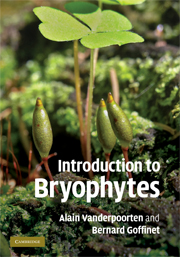5 - Hornworts
Published online by Cambridge University Press: 05 June 2012
Summary
Hornworts (Division Anthocerotophyta) compose the least diverse lineage of bryophytes. Their name refers to the horn-like sporophyte that lacks a seta and dehisces along one or two vertical lines (Fig. 5.1a). They further differ from mosses by the lack of leaves. Their vegetative body is indeed thalloid and rosette or ribbon-shaped and thereby resembles that of some liverworts. Also like liverworts, hornworts lack conspicuous and constant diagnostic gametophytic features and assigning a thallus to one lineage or another relies on microscopic characters. Although morphologically rather simple in architecture, hornworts may be physiologically elaborate organisms. Many species establish and maintain intimate symbiotic associations with endophytic nitrogen-fixing cyanobacteria and endomycorrhizal fungi. Furthermore, hornworts have carbon-concentrating mechanisms lacking in other bryophytes. Phylogenetically, hornworts appear more derived than mosses and liverworts, too: recent studies suggest that they alone share a unique common ancestor with vascular plants. Although easily overlooked in the field because of their often thin and when dry, dark thallus and neglected by biologists for their low global diversity, hornworts are drawing increasing attention for their significance in the evolution of land plants and their partnerships with endosymbionts.
- Type
- Chapter
- Information
- Introduction to Bryophytes , pp. 106 - 123Publisher: Cambridge University PressPrint publication year: 2009



